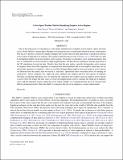Files in this item
A space weather tool for identifying eruptive active regions
Item metadata
| dc.contributor.author | Pagano, Paolo | |
| dc.contributor.author | Mackay, Duncan Hendry | |
| dc.contributor.author | Yardley, Stephanie Louise | |
| dc.date.accessioned | 2019-10-10T11:30:05Z | |
| dc.date.available | 2019-10-10T11:30:05Z | |
| dc.date.issued | 2019-11-22 | |
| dc.identifier | 260661788 | |
| dc.identifier | 0634b9bd-1a39-461b-a28c-0afcaa3a3956 | |
| dc.identifier | 85077356630 | |
| dc.identifier | 000499380000001 | |
| dc.identifier.citation | Pagano , P , Mackay , D H & Yardley , S L 2019 , ' A space weather tool for identifying eruptive active regions ' , Astrophysical Journal , vol. 886 , no. 2 , 81 . https://doi.org/10.3847/1538-4357/ab4cf1 | en |
| dc.identifier.issn | 0004-637X | |
| dc.identifier.other | ORCID: /0000-0001-6065-8531/work/66069971 | |
| dc.identifier.uri | https://hdl.handle.net/10023/18639 | |
| dc.description | Funding: UK Science and Technology Facilities Council (UK) through the consolidated grant ST/N000609/1 and the European Research Council (ERC) under the European Union Horizon 2020 research and innovation program (grant agreement No. 647214); UK STFC via the Consolidated Grant SMC1/YST025 and SMC1/YST037 (S.L.Y.); UK STFC and the ERC (SynergyGrant: WHOLE SUN, Grant Agreement No. 810218) for financial support (DHM). | en |
| dc.description.abstract | One of the main goals of solar physics is the timely identification of eruptive active regions. Space missions such as Solar Orbiter or future Space Weather forecasting missions would largely benefit from this achievement.Our aim is to produce a relatively simple technique that can provide real time indications or predictions that an active region will produce an eruption. We expand on the theoretical work of Pagano et al.(2019) that was able to distinguish eruptive from non-eruptive active regions.From this we introduce a new operational metric that uses a combination of observed line-of-sight magnetograms, 3D data-driven simulations and the projection of the 3D simulations forward in time. Results show that the new metric correctly distinguishes active regions as eruptive when observable signatures of eruption have been identified and as non-eruptive when there are no observable signatures of eruption. After successfully distinguishing eruptive from non-eruptive active regions we illustrate how this metric may be used in a “real-time” operational sense were three levels of warning are categorised. These categories are: high risk (red), medium risk (amber) and low risk (green) of eruption. Through considering individual cases we find that the separation into eruptive and non-eruptive active regions is more robust the longer the time series of observed magnetograms used to simulate the build up of magnetic stress and free magnetic energy within the active region. Finally, we conclude that this proof of concept study delivers promising results where the ability to categorise the risk of an eruption is a major achievement. | |
| dc.format.extent | 323747 | |
| dc.language.iso | eng | |
| dc.relation.ispartof | Astrophysical Journal | en |
| dc.subject | Solar active regions | en |
| dc.subject | Solar coronal mass ejections | en |
| dc.subject | Space weather | en |
| dc.subject | Solar magnetic fields | en |
| dc.subject | Solar active region magnetic fields | en |
| dc.subject | QB Astronomy | en |
| dc.subject | QC Physics | en |
| dc.subject | 3rd-NDAS | en |
| dc.subject.lcc | QB | en |
| dc.subject.lcc | QC | en |
| dc.title | A space weather tool for identifying eruptive active regions | en |
| dc.type | Journal article | en |
| dc.contributor.sponsor | European Research Council | en |
| dc.contributor.sponsor | Science & Technology Facilities Council | en |
| dc.contributor.sponsor | Science & Technology Facilities Council | en |
| dc.contributor.sponsor | Science & Technology Facilities Council | en |
| dc.contributor.institution | University of St Andrews. Applied Mathematics | en |
| dc.identifier.doi | 10.3847/1538-4357/ab4cf1 | |
| dc.description.status | Peer reviewed | en |
| dc.identifier.grantnumber | 810218 | en |
| dc.identifier.grantnumber | N/A | en |
| dc.identifier.grantnumber | ST/S000402/1 | en |
| dc.identifier.grantnumber | ST/N000609/1 | en |
This item appears in the following Collection(s)
Items in the St Andrews Research Repository are protected by copyright, with all rights reserved, unless otherwise indicated.

